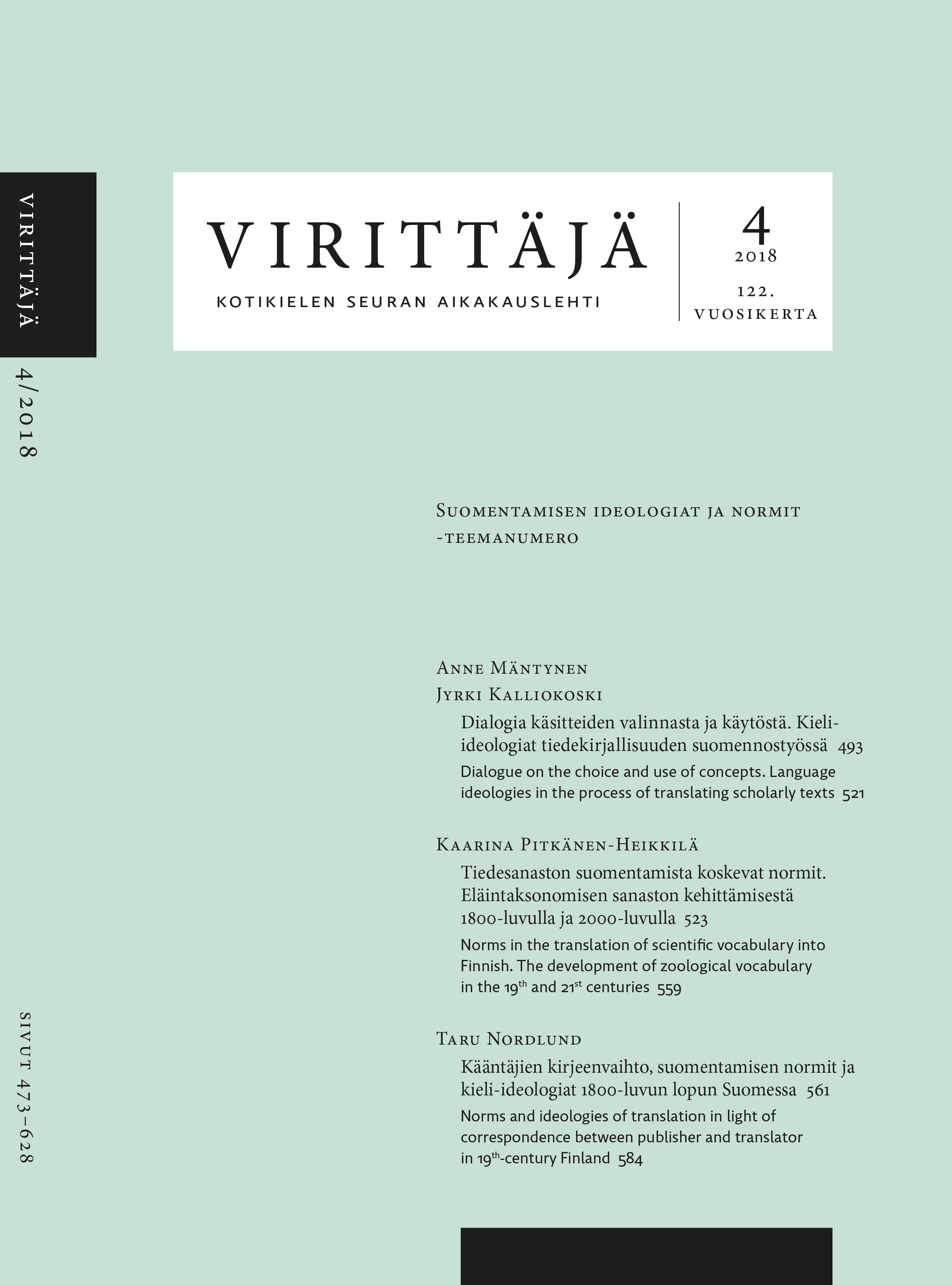Tiedesanaston suomentamista koskevat normit
Eläintaksonomisen sanaston kehittämisestä 1800-luvulla ja 2000-luvulla
Abstrakti
Artikkeli tarkastelee eläintaksonomisen sanaston kehittämistä suomen kieleen 1800-luvulla. 1800-luvun sanastotyötä tarkastellaan käyttäen aineistona kolmeatoista julkaistua tietokirjaa vuosilta 1856–1881. Tutkimuksessa hyödynnetään myös niiden arvosteluja sekä kääntäjien ja kirjoittajien esipuheita ja kirjeenvaihtoa. Pohjatekstien ja käännösten sekä vieraskielisten termien ja niiden suomennosten vertailu tuovat esiin sanastonkehittäjien työssä vaikuttaneet normit. Myös oheistekstit kertovat näistä konventioista ja varsinkin siitä, kuinka hyvin kääntäjät itse tiedostivat ne. Kirjeenvaihto paljastaa yhteistyöverkostot ja avaa kirjoitusprosessia, kun taas kirja-arviot kertovat teosten ja niiden sanaston saamasta vastaanotosta.
Artikkelissa myös verrataan eläintieteellisessä sanastonkehittelyssä 1800-luvulla vaikuttaneita normeja 2000-luvun alun laajaan sanastoprojektiin, jossa nisäkäsnimistö sai runsaasti uusia nimiä ja jolloin myös monia vanhoja nimiä muutettiin. Tutkimus osoittaa, että sanaston aukkojen täyttämisen keinot olivat 1800-luvun tietokirjatyössä melko erilaiset kuin 2000-luvun nimistöhankkeessa. Uudet keinot ovat johtaneet usein läpinäkymättömiin termeihin: käännöslainojen (esim. imettävät eläimet < ruots. däggande djur) sijaan suositaan lainasanoja (esim. kolokolot < engl. colocolos), ja yhdistämisen ja johtamisen sijaan on käytetty runsaasti uudenlaisia sananmuodostuskeinoja, muun muassa lyhentämistä (häntähekot ← pitkähäntähedelmälepakot) ja kontaminaatioita (jyystiäiset ← jyrsijäpäästäiset). 2000-luvun sanastotyössä vaikuttaneita normeja tarkastellaan nisäkäsnimistötoimikunnan omien periaatteiden ja toteutuneen työn lisäksi siinä laajassa keskustelussa, jota käytiin vuodesta 2008 alkaen niin Luonnontieteellisen keskusmuseon verkkosivustolla kuin lehdistössäkin.
Artikkeli osoittaa, että osa sanastotyötä ohjaavista käytänteistä on sellaisia, jotka ovat vaikuttaneet työhön 1800-luvulla ja vaikuttavat nykyisinkin. Aiheita, jotka ovat puhuttaneet sekä varhaisnykysuomen ajalla että nykyisessä digisuomen ajassa, ovat vakiintuneisuus, vierasperäisyys, läpinäkyvyys, loogisuus, selkeys, taksonominen systemaattisuus ja sanastotyön tekijän asiantuntijuus. Artikkeli osoittaa, että tietokirjojen kirjoittajien ja suomentajien valinnat ovat merkittäviä erikoisalan sanastotyölle ja että tieteellisellä sanastolla ja sen suomentamisella on oma normistonsa. Normeista poikkeaminen voi herättää laajan julkisen keskustelun, kuten kävi kymmenen vuotta sitten.
Norms in the translation of scientific vocabulary into Finnish: The development of zoological vocabulary in the 19th and 21st centuries
The article examines the development of zoological vocabulary in Finnish and norms influencing the formation of scientific vocabulary, particularly during the 19th century. By examining 13 non-fiction books published between 1856 and 1881 and their associated source texts, the article explores the translation and development of scientific vocabulary within the discipline of zoology. In addition, this vocabulary-developing project is explained using paratexts: book reviews, forewords by writers or translators, and correspondence between actors. The comparison of source and target texts reveals the many solutions that authors and translators have employed and the conventions they have absorbed. These paratexts reveal norms and conventions, as well as translators’ awareness of these norms. The correspondence between actors reveals collaboration networks and opens up the word formation process, whereas book reviews provide much information about how readers received such new vocabularies.
The vocabulary project in 19th-century zoology is here compared to the reformation of Finnish mammal nomenclature at the beginning of the 21st century. This study demonstrates that the methods of filling the vocabulary gaps in the scientific Finnish of the 21st century differ conclusively from the methods used in the 19th century. During the 19th century, loan translations (e.g. imettävät eläimet < Swed. däggande djur) were typical, and new words were formed transparently, primarily by compounding and deriving from existing domestic material. Contrastingly, the vocabulary creation methods of the 21st century have produced words that are more opaque: loan words (e.g. kolokolot < Engl. colocolos) have been formed instead of loan translations and semantically unclear abbreviations (häntähekot ← pitkähäntähedelmälepakot), and blends (jyystiäiset ← jyrsijä-päästäiset) have been formed alongside many miscible compounds and derivations.
The comparison of paratexts shows that the same subjects were discussed in the period of early modern Finnish as during the current days of modern Finnish. The discussion makes many norms visible, e.g. the establishment, transparency, logicality, clarity, taxonomical systematicity and expertism of authors and translators. Vocabulary must be understandable, clear and transparent; logicality and taxonomical systematicity are also required. Established vocabulary should be retained. The developers of scientific vocabularies require expertise in both the source language and the subject field.
The article demonstrates that, with regard to special vocabulary, authors’ and translators’ choices are significant, and the translation of scientific vocabulary has norms of its own – and can therefore lead to broad public discussion.






